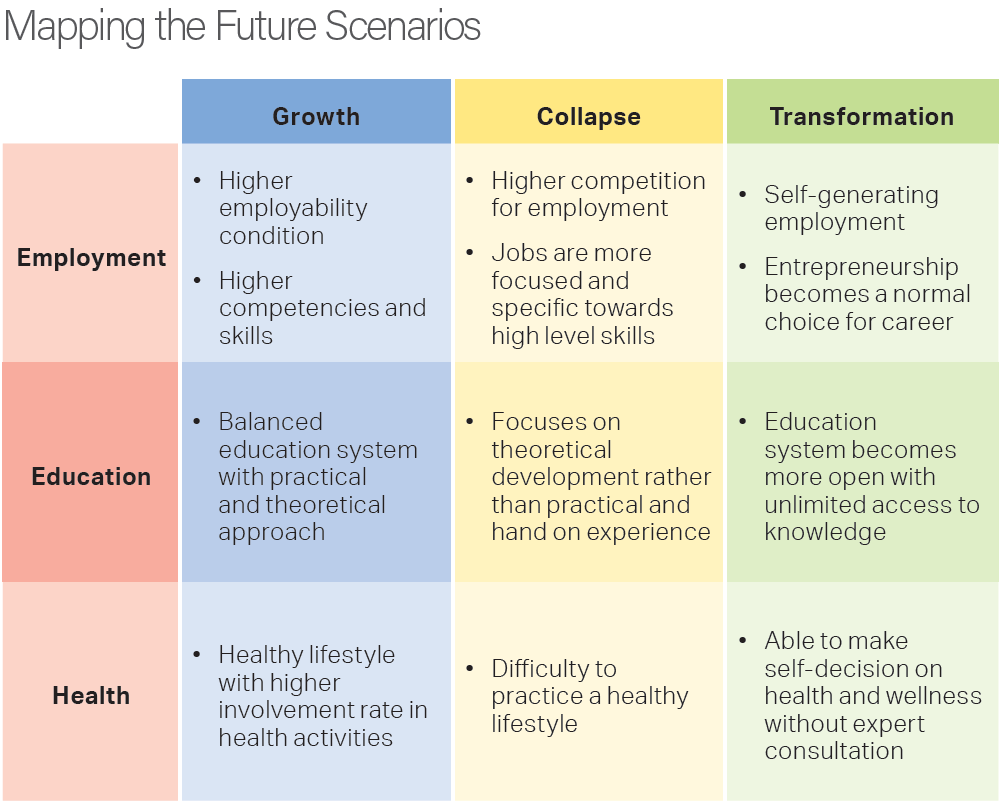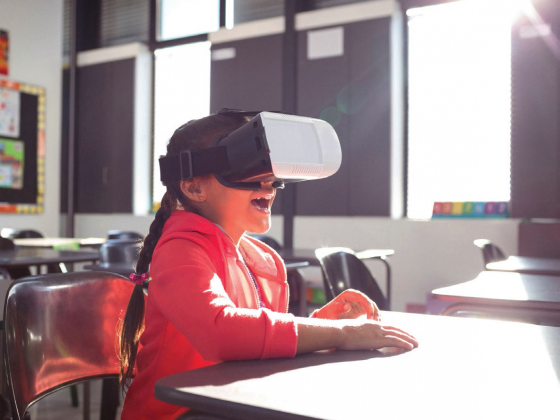by | Norsam Tasli Mohd Razali | norsamtasli@might.org.my
In an ever-changing and challenging world, the future of a nation relies on the next generation. Currently, there ar e about 1.8 billion young people between the ages of 10-24, the largest youth population in human history, with the majority of these youth residing in developing countries.
In Malaysia, as of 2016, there are more than 5 million youth between the ages of 15-24, making them the third largest group in population. These are the future movers and shakers. Therefore, the importance of their strength, knowledge, and skill is more pertinent than ever.
Youth need to be guided with a variety of plans and equipped with competencies that enable them to face the unprecedented changes that can come from technological, economic, social and political aspects. It is important to explore future opportunities and threats that may affect the future development of youth in any given nation.
But What’s Shaping the Future of Youth?
In years to come, the progress of youth development will be driven by a variety of interconnected forces. Transformative forces such as change in population, technology
advancement, government policies and personal core values will influence the future of youth employment, education and state of health. Understanding these forces and their impacts on youth development provides great insight of what to expect in the future.
- Demographic Change: The world’s population is projected to reach 8.5 billion in 2030, and the number of youth will peak at 1.3 billion. This vast increment in population is driven by urban migrations, advancement in health technology and facilities, as well as stronger family institutions — not to mention an overall improvement in general wellbeing and in the quality of life. This change in demographic population will transform the role of youth and their involvement in further development of a nation.
- Economic Growth: By the year 2030, Global economic growth is expected to continue at approximately 4 percent per annum, with a two-fold increase in Gross Domestic Product (GDP). A change in the global economy will impact an open economy and trading nations such as Malaysia. This in turn will affect the pace of urbanisation, as it will be further driven by urban migration and low mortality rates among urbanites. As one of the biggest populations on earth, young people will be affected by rapid and unplanned urbanisation, causing growth inequalities and job scarcity.
- Science, Technology, and Innovation (STI) Ecosystem: According to Forbes, it is projected that more than 2 billion jobs will disappear worldwide to future technology and automation. As the world is entering its fourth industrial revolution, emergence of Internet of Things (IoT) such as digital systems, networked communications, and large-scale data availability will provide the youth with unlimited information. This revolution will mark new opportunities and challenges for young people to take on. Science and technology will be the leading industries in the future—the syllabi in learning institutions must stay
relevant and be STEM and innovative subjects-centric to better equip the
youth of the future. - Leaderships & Governance: As community members become more responsible and self-aware of their roles in community development, there is an increase in volunteerism and non-state actors (the rise of the 3rd sector) to bring changes aimed toward improving a community’s quality of life. A successful implementation of policies relies on political stability and improved
national security, driven by the 3rd sectors roles. This will be a platform for youth to get involved and be enriched in their leadership roles in
the community. - Values: Malaysia is known for its multicultural and multi-ethnic society, sharing the same principles and values. Future youth must understand that in order to create a happy nation, efforts must be made to achieve a balanced and satisfying life for individuals, family members, and community. The growth of a nation
depends on stronger social ties, better-managed commons, and a strong sense of community. Important values are incorporated on all aspects of work and activities, at home and workplace.
Exploring the Future Scenarios for Youth
Understanding how changes affect the above-mentioned drivers is critical to the formulation of proper responses and solutions towards positive growth of the youth. For the purpose of this study, three plausible scenarios have been developed in the perspective of growth, collapse, and transformation of Malaysian youth in the future. The overview of each scenario is explored in three different areas:
Employment: explores any changes of traits influenced by drivers especially on job opportunities, skills and competencies requirement.
Education: explains elements that are related to the education system in Malaysia and how talents are developed.
Healthcare: touches on the physiological and psychological health of youth.


In a thriving environment, youth in Malaysia are living a healthier and a more mindful life. Changes are positively embraced and sustainability living is at the heart of all aspects in life. Young society is more physically and mentally fit, more knowledgeable,
more diverse and more inclusive, as well as being equipped with the necessary skills to take on challenges in both school and the workplace.
EMPLOYMENT
Positive economic growth in Malaysia prepares the work ecosystem with high employability conditions. Youth employment is critical to building stronger communities, with a marked need for greater collaboration between educators and employers. Receptiveness towards new challenges and trends
such as industrial revolution and technology innovation, will further equip future youth with high competencies and skills that are relevant to the industry’s requirement.
EDUCATION
Education is no longer just about learning tangible and measurable skills. Although youth should be prepped in core subjects, it is also important that they be taught how to learn. Malaysia’s holistic education redefines pertinent subjects and how youth should be taught making it not just about mental development, but encompassing psychological, social and emotional growth as well. What they learn in and outside of the classroom is more relevant than ever to meet future industry requirements. Youth have become more practical and relevant as they gain knowledge by doing, not
just reading.
HEALTH
Generally, youth population are healthier—physically, mentally, and spiritually. As the education system becomes more holistic, youth are more involved in school activities and programmes that focus on character development. Not only that, having a
healthy lifestyle becomes a cool trend where youth strive for positive values, attitudes, and a healthy body image.

A lack of stability in the nation has led to the downfall of quality of life affecting the youth. With limited resources available, sustainability agendas and policies are not effectively implemented, creating tension among Malaysians. The nation is further
divided when social values, level of education, and health conditions are declining. Unplanned development has caused many youth to fall through the cracks, making them more incompetent and less educated.
EMPLOYMENT
Job opportunities are scarce, causing high competition rate among youth, with robots and automation taking over human jobs—especially in manufacturing and engineering fields. Globalisation and communication technology advancement have levelled the playing field across the board, forcing local youth to compete with global talent.
Job requirements are also becoming more niched, requiring specific skills and knowledge.
EDUCATION
There is not much improvement in the education system that would enhance youth experiences, knowledge, and skills needed to face the future. The education system is too focused on an exam-based format as opposed to the practical, hands-on format.
The learning environment has become so rigid that the system often neglects the importance of variety in classrooms such as cultural, social, creative arts, and technology lessons. School becomes a burden to the students as they view it as a rigid learning institution. This will eventually cause a higher rate of dropout, incompetent talents, a low rate of literacy, and an ignorant generation.
HEALTH
With poor education and lack of job opportunities, youth are not able to compete and cope with the fast-changing developments. Mental and physical health becomes a major concern as more youth are struggling to keep a balanced lifestyle. Pollution is rampant, giving way to new diseases spreading among young people.

Technology is the key component towards a positive development. The future of work is being automated in manufacturing, engineering, and communication, among other sectors. With the help of technology advancement, the focus has shifted to a sustainable economy that seeks to preserve limited natural resources due to unplanned development.
EMPLOYMENT
In the twenty-first century, the ease of coordinating tasks enables workers to get more done outside of large organisations. Digital transformation such as Artificial Intelligence and automation creates better adaptable, resilient, and flexible young workers. It rewards highly entrepreneurial individuals who are skilled at finding and assembling resources and coordinating task flows. Combined with innovation skills, a considerable number of youth turn to innopreneurship—a combination of innovative skills and entrepreneurships skills—to gain competitive advantage over their peers and as a foundation to many entry-level work, as well as startups.
EDUCATION
The transformation from the traditional learning education system to a digital literate generation creates an infinite access to knowledge for the youth. With vast information at hand, non-traditional education (a systematic education offered outside
the framework of the formal education system) complements formal education to encourage productivity growth among this young population.
HEALTH
Youth are leading the charge by making health-promoting diet and life choices a priority. Today’s informed youth are no longer in a purely reactive mode when it comes to their health needs. They are the most willing to take initiative on behalf of their well-being and they become more engaged in their quest for good health, better time management, longevity and independence. Making mindful decisions about a healthy and balanced lifestyle has never been easier for young people with the help of advanced communication technology. Vast information is now readily available with a single click or tap without the help of an expert.
![]()
Raising Today’s Youth For Tomorrow’s Hope
It takes concerted, all-out efforts from various stakeholders to unleash the full potential of youth. Government, parents, knowledge institutions, and industry players at all levels must come together to guide and pave positives ways for these future leaders.
To get a glimpse of tomorrow’s future, it is critical to anticipate future opportunities and threats, as discussed in three plausible future scenarios for the youth above. Further analysis is required to explore potential opportunities and threats within each scenario. It is hoped that with the right strategies and inclusive policies, the future of youth ecosystem will be secured and preserved for generations to come.










